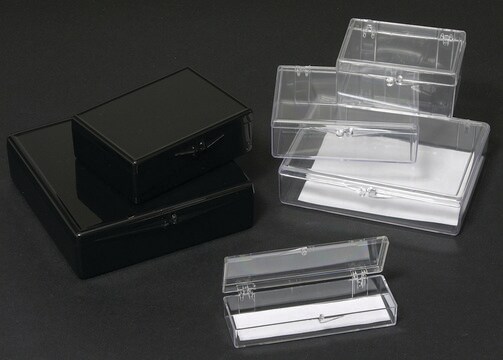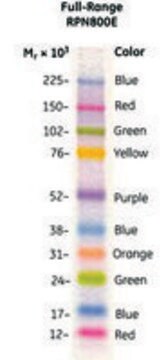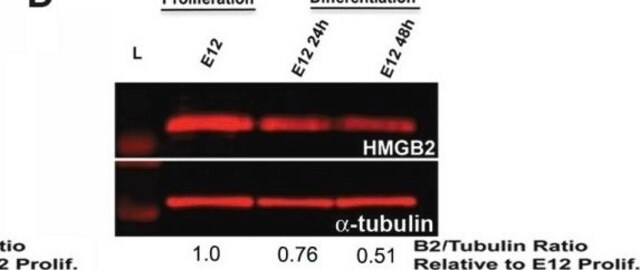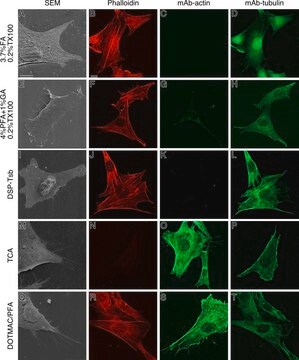ABS2103
Anti-BiP (GRP78) Antibody, arginylated (Nt-Glu19)
from rabbit, purified by affinity chromatography
Sinónimos:
78 kDa glucose-regulated protein, Nt-Glu19 arginylated, BiP, Nt-Glu19 arginylated, Endoplasmic reticulum lumenal Ca(2+)-binding protein grp78, Nt-Glu19 arginylated, GRP-78, Nt-Glu19 arginylated, Heat shock 70 kDa protein 5, Nt-Glu19 arginylated, Immunogl
About This Item
Productos recomendados
origen biológico
rabbit
Nivel de calidad
forma del anticuerpo
affinity isolated antibody
tipo de anticuerpo
primary antibodies
clon
polyclonal
purificado por
affinity chromatography
reactividad de especies
human, mouse
reactividad de especies (predicha por homología)
rat (based on 100% sequence homology), bovine (based on 100% sequence homology), nonhuman primates (based on 100% sequence homology)
técnicas
ELISA: suitable
dot blot: suitable
immunocytochemistry: suitable
western blot: suitable
Nº de acceso NCBI
Nº de acceso UniProt
Condiciones de envío
ambient
modificación del objetivo postraduccional
unmodified
Información sobre el gen
human ... HSPA5(3309)
Descripción general
Especificidad
Inmunógeno
Aplicación
Signaling
Immunocytochemistry Analysis: 10 µg/mL from a representative lot detected BiP Nt-Glu19 arginylation induction in (18-hr 3 µM MG132 and 200 nM thapsigargin) treated HeLa cells (Courtesy of Yong Tae Kwon, Ph.D. , Seoul National University, Korea).
Immunocytochemistry Analysis: 10 µg/mL from a representative lot detected BiP Nt-Glu19 arginylation induction in (18-hr 3 µM MG132 and 200 nM thapsigargin) treated wild-type, but not arginine-tRNA-protein transferase 1/ATE1-deficient, MEFs (Courtesy of Yong Tae Kwon, Ph.D. , Seoul National University, Korea).
Western Blotting Analysis: 0.2 µg/mL from a representative lot detected BiP Nt-Glu19 arginylation induction in (18-hr 3 µM MG132 and 200 nM thapsigargin) treated HeLa cells (Courtesy of Yong Tae Kwon, Ph.D. , Seoul National University, Korea).
Western Blotting Analysis: 0.2 µg/mL from a representative lot detected a target R-BiP(19-651)-GFP fusion band in MEF cells transfected to express Ub-R-BiP(19-651)-GFP or Ub-BiP(19-651)-GFP, but not Ub-V-BiP(19-651)-GFP. In ATE1-deficient MEFs, the target R-BiP(19-651)-GFP band was detected only when the cells were tranfected to express Ub-R-BiP(19-651)-GFP, but not Ub-BiP(19-651)-GFP (Courtesy of Yong Tae Kwon, Ph.D. , Seoul National University, Korea).
Dot Blot Analysis: A representative lot detected the immunogen peptide, but not the control peptide without arginylation at the N-terminal Glu19 (Cha-Molstad, H., et al. (2015). Nat. Cell Biol. 17(7):917-929).
ELISA Analysis: A representative lot detected the immunogen peptide, but not the control peptide without arginylation at the N-terminal Glu19 (Cha-Molstad, H., et al. (2015). Nat. Cell Biol. 17(7):917-929).
Immunocytochemistry Analysis: A representative lot detected poly(dA:dT) transfection-induced formation of BiP arginylation/R-BiP-positive puncta co-localized with those containing p62, LC3, and ubiquitin conjugates, while R-BiP and ER stainings are mutually exclusive (Cha-Molstad, H., et al. (2015). Nat. Cell Biol. 17(7):917-929).
Western Blotting Analysis: A representative lot detected the production of R-BiP(19-651)-Tag fusions from exogenously expressed Ub-BiP(19-N)-Tag and Ub-R-BiP(19-N)-Tag, but not Ub-V-BiP(20-N)-Tag, constructs. In ATE1-deficient cells, the target R-BiP(19-651)-GFP band was detected only when the cells were tranfected to express Ub-R-BiP(19-651)-GFP, but not Ub-BiP(19-651)-GF (Cha-Molstad, H., et al. (2015). Nat. Cell Biol. 17(7):917-929).
Western Blotting Analysis: A representative lot detected BiP (GRP78) Nt-Glu19 arginylation induction upon arginine-tRNA-protein transferase 1 (ATE1) 1A7A isoform overexpression or transfection of various dsDNAs, including poly(dA:dT), in HeLa cells. Combined proteasome inhibition and ER stress induction by an 18-hr 10 µM MG132 and 100 nM thapsigargin treatment synergized the two drugs′ efficacy toward cellular Calreticulin Nt-Glu18 arginylation induction (Cha-Molstad, H., et al. (2015). Nat. Cell Biol. 17(7):917-929).
Calidad
Western Blotting Analysis: 1 µg/mL of this antibody detected BiP (GRP78) Nt-Glu19 arginylation induction in 7.5 µg of lysate from (17-hr 3 µM MG132 and 200 nM thapsigargin) treated HEK293 cells.
Descripción de destino
Forma física
Almacenamiento y estabilidad
Otras notas
Cláusula de descargo de responsabilidad
¿No encuentra el producto adecuado?
Pruebe nuestro Herramienta de selección de productos.
Código de clase de almacenamiento
12 - Non Combustible Liquids
Clase de riesgo para el agua (WGK)
WGK 2
Punto de inflamabilidad (°F)
Not applicable
Punto de inflamabilidad (°C)
Not applicable
Certificados de análisis (COA)
Busque Certificados de análisis (COA) introduciendo el número de lote del producto. Los números de lote se encuentran en la etiqueta del producto después de las palabras «Lot» o «Batch»
¿Ya tiene este producto?
Encuentre la documentación para los productos que ha comprado recientemente en la Biblioteca de documentos.
Nuestro equipo de científicos tiene experiencia en todas las áreas de investigación: Ciencias de la vida, Ciencia de los materiales, Síntesis química, Cromatografía, Analítica y muchas otras.
Póngase en contacto con el Servicio técnico






